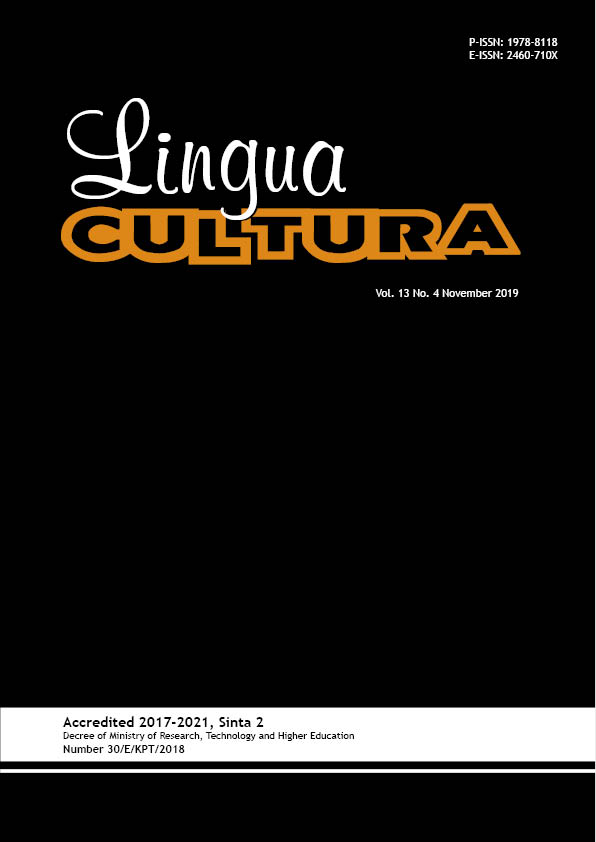The Cultural Meaning in Verbal and Non Verbal Expression Represented in Nyaébuh Tradition of People in Aeng Tong-tong, Saronggi, Sumenep
DOI:
https://doi.org/10.21512/lc.v13i4.5933Keywords:
cultural meaning, verbal expression, non-verbal expression, nyaébuh tradition, ethnolinguisticsAbstract
This research aimed to find out the cultural meaning of verbal and non-verbal expression represented in the nyaébuh tradition of people in Aeng tong-tong, Saronggi, Sumenep. This research was a qualitative descriptive using an ethnographic method with ethnoscience analysis. Data were obtained from the interview result with two informants of verbal and non-verbal expression. It finds that this tradition in the form of almsgiving whereby the charity is devoted to the deceased in the hope that it can alleviate and erase the sins of the deceased, in addition to which it can increase unity, harmony, family, harmony between people and others. This research can provide the benefits of knowledge about the meaning contained in the tradition of nyaébuh, and it can give the Sumenep community’s insights about the meaning of tradition through verbal and non-verbal language expressions. Besides that, it can share knowledge about the culture and traditions of Madura for each different region.
Â
References
Ayu, N. P. (2014). Konsep hidup dan mati dalam leksikon Khaul BuyutTambi (Kajian Etnolinguistik di Indramayu). Bahtera Sastra: Antologi Bahasa Dan Sastra Indonesia, 1, 11-17.
Embon, D., & Saputra, I. G. K. A. (2018). Sistem simboldalam upacara adat Toraja Rambu Solo: Kajian semiotik. Bahasa dan Sastra, 3(7), 1-10.
Hodairiyah, D. (2019). Lexical and cultural meanings of the majesty Sortana tradition in death salvation of Aeng Tong-tong Madura society. Proceedings Of The Third International Conference of Arts, Language and Culture (ICALC 2018), 279, 189–196.
Karim, A. (2017).Makna ritual kematian dalam tradisi Islam Jawa. Sabda: Jurnal Kajian Kebudayaan, 12(2), 161-171. https://doi.org/10.14710/sabda.12.2.161-171.
Mulyadi, A. (2018). Memaknai praktik tradisi ritual masyarakat Muslim Sumenep. Endogami: Jurnal Ilmiah Kajian Antropologi, 1(2), 124-135. https://doi.org/10.14710/endogami.1.2.124-135.
Pangaribuan, R. (2017). Implementation of the Toba Batak community Death Salvation in Pontianak City. Prodi Hukum UNTAN, 3(5), 1–56.
Rais, W. (2017). Kearifan lokal dalam bahasa dan budaya Jawa: Studi kasus masyarakat nelayan di pesisir selatan Kebumen, Jawa Tengah (Kajian Etnolinguistik). Surakarta: UNS Press.
Samingin, F. X. (2007). Perilaku verbal dan non-verbal pada upacara kematian dalam tradisi Jawa: Kajian etnolinguistik. Magelang: Universitas Tidar Magelang.
Sari, D. (2017). Selametan kematian di desa Jaweng, kabupaten Boyolali. Haluan Sastra Budaya, 2(1), 147–161.
Suwito., Hidayat, A., & Agus, S. (2015). Tradisi dan ritual kematian wong Islam Jawa. Ibda’ Jurnal Kebudayaan Islam, 13(2), 1693– 6736. doi 10.24090/IBDA.V13I2.659.
Wahyuningsih, D. (2018). The representation of the Toraja tribal death ritual ceremony in the Indonesia Net Tv Episode Toraja Documentary Program. E-Journal Ilmu Komunikasi, 6(1), 68–82.
Downloads
Published
How to Cite
Issue
Section
License
Authors who publish with this journal agree to the following terms:
a. Authors retain copyright and grant the journal right of first publication with the work simultaneously licensed under a Creative Commons Attribution License - Share Alike that allows others to share the work with an acknowledgment of the work's authorship and initial publication in this journal.
b. Authors are able to enter into separate, additional contractual arrangements for the non-exclusive distribution of the journal's published version of the work (e.g., post it to an institutional repository or publish it in a book), with an acknowledgment of its initial publication in this journal.
c. Authors are permitted and encouraged to post their work online (e.g., in institutional repositories or on their website) prior to and during the submission process, as it can lead to productive exchanges, as well as earlier and greater citation of published work.
USER RIGHTS
All articles published Open Access will be immediately and permanently free for everyone to read and download. We are continuously working with our author communities to select the best choice of license options, currently being defined for this journal as follows: Creative Commons Attribution-Share Alike (CC BY-SA)


















